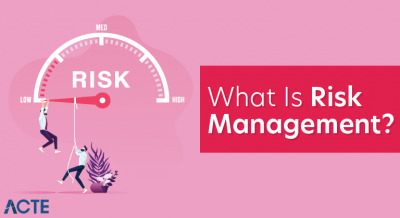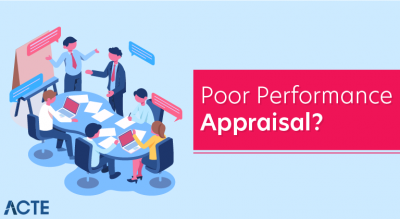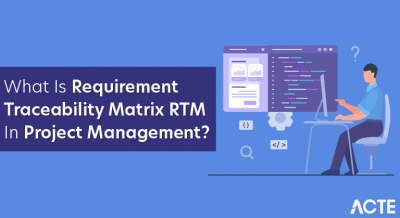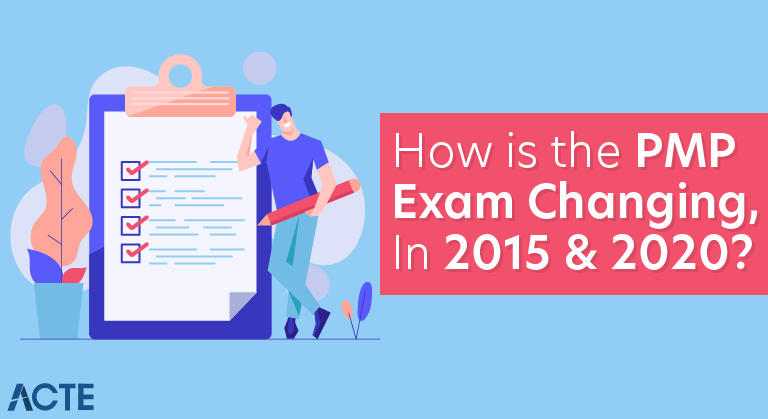
An accomplished Role Delineation Study (RDS) has updated the description of the project management professional role. The study included the survey of PMP credentials holders to certify updates to domains, tasks, knowledge, and skills. The RDS captures the outlook of project management practitioners from all organizations and it performs all the duties regarding PMP exam and certifies its validity.
How is the PMP altered?
The five domains for the PMP exam remain the same. In spite of that the tasks with each domain have been changed. The prevailing exam will be active till 1 November 2015, after November 1 only the new pattern of exam will be conducted.
What is changing on the exam?The new PMP Exam Content Outline includes two changes that will have a significant impact on the PMP Exam. First, the ECO states that half the questions will represent predictive project management approaches and the other half will represent agile or hybrid approaches. Second, the domains and their related tasks have changed. The 2015 ECO organizes the questions by the 5, familiar domains (Process Groups). The 2019 ECO groups the questions by 3 domains. Those domains and the question allocation are below:
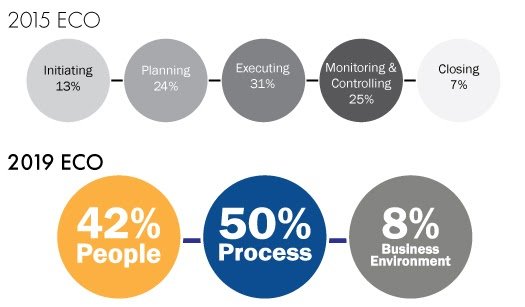
PERFORMANCE DOMAIN I: INITIATING THE PROJECT
| S.no | Domain I | Initiating the Project |
| Task 1 | Perform project assessment based upon available information, lessonslearned from previous projects, and meetings with relevant stakeholders, in order to support the evaluation of the feasibility of new products or services within the given assumptions and/or constraints. | |
| Task 2 | Identify key deliverables based on the business requirements, in order tomanage customer expectations and direct the achievement of project goals. | |
| Task 3 | Perform stakeholder analysis using appropriate tools and techniques, inorder to align expectations and gain support for the project. | |
| Task 4 | Identify high level risks, assumptions, and constraints based on the current environment, organizational factors, historical data and expert judgment, in order to propose an implementation strategy. | |
| Task 5 | Participate in the development of the project charter by compiling andanalyzing gathered information, in order to ensure project stakeholders are in agreement on its elements. | |
| Task 6 | Obtain project charter approval from the sponsor, in order to formalize the authority assigned to the project manager and gain commitment andacceptance for the project. | |
| Task 7 | Conduct benefit analysis with stakeholders (including sponsor, customer,subject matter experts), in order to validate project alignment withorganizational strategy and expected business value. | |
| Task 8 | Inform stakeholders of the approved project charter, in order to ensurecommon understanding of the key deliverables, milestones, and their roles and responsibilities. |
PERFORMANCE DOMAIN II: PLANNING THE PROJECT
| DOMAIN II | PLANNING THE PROJECT |
| Task 1 | Review and assess detailed project requirements, constraints, andassumptions with stakeholders based on the project charter, lessons learned, and by using requirement gathering techniques, in order to establish detailed project deliverables. |
| Task 2 | Develop a scope management plan, based on the approved project scope and using scope management techniques, in order to define, maintain, and manage the scope of the project. |
| Task 3 | Develop the cost management plan based on the project scope, schedule, resources, approved project charter and other information, using estimating techniques, in order to manage project costs. |
| Task 4 | Develop the project schedule based on the approved project deliverables and milestones, scope, and resource management plans, in order to manage timely completion of the project. |
| Task 5 | Develop the human resource management plan by defining the roles and responsibilities of the project team members, in order to create a project organizational structure and provide guidance regarding how resources will be assigned and managed. |
| Task 6 | Develop the communications management plan based on the projectorganization structure and stakeholder requirements, in order to define and manage the flow of project information. |
| Task 7 | Develop the procurement management plan based on the project scope, budget, and schedule, in order to ensure that the required project resources will be available. |
| Task 8 | Develop the quality management plan and define the quality standards for the project and its products, based on the project scope, risks, and requirements, in order to prevent the occurrence of defects and control the cost of quality. |
| Task 9 | Develop the change management plan by defining how changes will beaddressed and controlled, in order to track and manage change. |
| Task 10 | Develop the risk management plan by identifying, analyzing, and prioritizing project risks, and defining risk response strategies, in order to manage uncertainty and opportunity throughout the project life cycle. |
| Task 11 | Present the project management plan to the relevant stakeholders according to applicable policies and procedures, in order to obtain approval to proceed with project execution. |
| Task 12 | Conduct kick-off meeting, communicating the start of the project, keymilestones, and other relevant information, in order to inform and engage stakeholders and gain commitment. |
| Task 13 | Develop the stakeholder management plan by analyzing needs, interests, and potential impact, in order to effectively manage stakeholders’ expectations and engage them in project decisions. |
PERFORMANCE DOMAIN III: EXECUTING THE PROJECT
| Domain III | Executing the Project |
|---|---|
| Task 1 | Acquire and manage project resources by following the human resource and procurement management plans, in order to meet project requirements. |
| Task 2 | Manage task execution based on the project management plan by leading and developing the project team, in order to achieve project deliverables. |
| Task 3 | Implement the quality management plan using the appropriate tools and techniques, in order to ensure that work is performed in accordance with required quality standards. |
| Task 4 | Implement approved changes and corrective actions by following the change management plan, in order to meet project requirements. |
| Task 5 | Implement approved actions by following the risk management plan, in order to minimize the impact of the risks and take advantage of opportunities on the project. |
| Task 6 | Manage the flow of information by following the communications plan, inorder to keep stakeholders engaged and informed. |
| Task 7 | Maintain stakeholder relationships by following the stakeholder management plan, in order to receive continued support and manage expectations. |
PERFORMANCE DOMAIN IV: MONITORING AND CONTROLLING THE PROJECT
| Domain IV | Monitoring and Controlling the Project |
|---|---|
| Task 1 | Measure project performance using appropriate tools and techniques, inorder to identify and quantify any variances and corrective actions. |
| Task 2 | Manage changes to the project by following the change management plan, in order to ensure that project goals remain aligned with business needs. |
| Task 3 | Verify that project deliverables conform to the quality standards established in the quality management plan by using appropriate tools and techniques, in order to meet project requirements and business needs. |
| Task 4 | Monitor and assess risk by determining whether exposure has changed and evaluating the effectiveness of response strategies, in order to manage the impact of risks and opportunities on the project. |
| Task 5 | Review the issue log, and update if necessary, and determine correctiveactions by using appropriate tools and techniques, in order to minimize the impact on the project. |
| Task 6 | Capture, analyze, and manage lessons learned using lessons learnedmanagement techniques, in order to enable continuous improvement. |
| Task 7 | Monitor procurement activities according to the procurement plan, in order to verify compliance with project objectives. |
PERFORMANCE DOMAIN V: CLOSING THE PROJECT
| Domain V | Closing the Project |
|---|---|
| Task 1 | Obtain final acceptance of the project deliverables from relevantstakeholders, in order to confirm that project scope and deliverables were achieved. |
| Task 2 | Transfer the ownership of deliverables to the assigned stakeholders inaccording to the project plan, in order to facilitate project closure. |
| Task 3 | Transfer the ownership of deliverables to the assigned stakeholders inaccording to the project plan, in order to facilitate project closure. |
| Task 4 | Transfer the ownership of deliverables to the assigned stakeholders inaccording to the project plan, in order to facilitate project closure. |
| Task 5 | Collate lessons learned that were documented throughout the project and conduct a comprehensive project review, in order to update theorganization’s knowledge base. |
| Task 6 | Archive project documents and materials using generally accepted practices, in order to comply with statutory requirements and for potential use in future projects and audits. |
| Task 7 | Obtain feedback from relevant stakeholders, using appropriate tools andtechniques and based on the stakeholder management plan, in order toevaluate their satisfaction. |
The ultimate version of the PMP exam content outline has not yet been decided. Also, the tasks, knowledge and skills are not included. This information will be obtained on or before 15 June 2015.
Here’s an outline of added tasks:
| Domain 1 | Initiating the Project 3 tasks added – task 2, task 7, task 8 |
| Domain 2 | Planning the Project 1 Task added – Task 13 |
| Domain 3 | Executing the Project 2 Tasks added – Task 6, Task 7 |
| Domain 4 | Monitoring and controlling the project 2 Tasks added – Task 6, task 7 |
| Domain 5 | Closing the project No new tasks added |
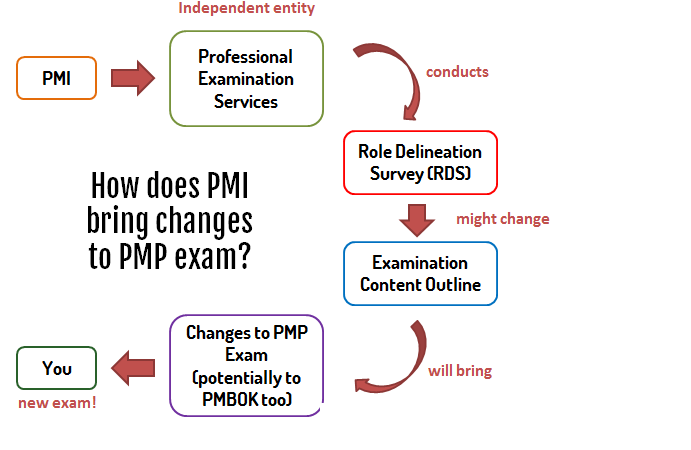
In a nutshell: the current PMP exam is based on 5 performance domains, but starting 2 January 2021 the exam will be based on 3 domains. These domains are defined in the PMP Exam Content Outline (ECO).
| DOMAIN | CURRENT ECO 2015 | NEW ECO 2019 |
| Domain I | Initiating | People |
| Domain II | Planning | Process |
| Domain III | Executing | Business Environment |
| Domain IV | Monitoring & Controlling | |
| Domain V | Closing |
Here is what this change from 5 to 3 domains means:
- PMI published the new exam content outline on 30 June 2019.
- The new outline is a ‘radical’ but extremely valuable departure from all previous exam content outlines
- The new PMP exam will require candidates to have experience in and answer questions from three domains:
- People (42%)
- Process (50%)
- Business Environment (8%)
- Within each of these three domains the exam content outline lists Tasks (what we project managers do) and Enablers (the actions we take to complete the tasks).
- PMI also clearly states that About half of the examination will represent predictive project management approaches and the other half will represent agile or hybrid approaches.

